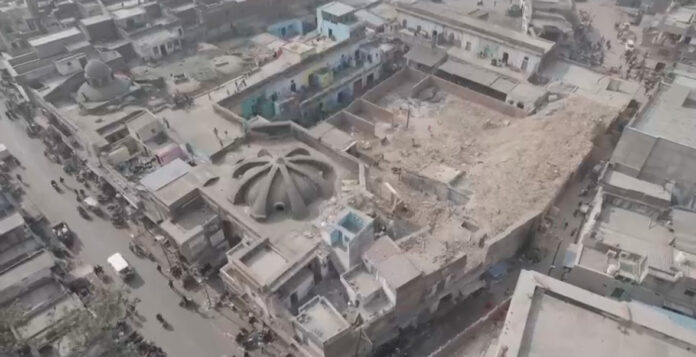Sanjana Chawla, TwoCircles.net
Lying on the banks of the Yamuna River in Uttar Pradesh, Agra is home to three UNESCO World Heritage Sites. While the Taj Mahal, Fatehpur Sikri and Agra Fort stand proudly as symbols of history and romance, a centuries-old monument is now in danger of being lost forever. The Shahi Hammam, a historical bathhouse dating back to Emperor Jahangir’s era, is being demolished by a private builder, with at least three houses already razed this year.
The Shahi Hammam, a grand Persian-style bathhouse built in 1620 by Ali Vardi Khan, was once a cultural hub. According to Volume VII of the District Gazetteers of the United Provinces of Agra and Oudh, the hammam was located in the Chhipi Tola and featured five arched gateways and a large courtyard surrounded by two-story chambers.
Tahir Ahmed, the founder of Agra Heritage Walk, says, “There is a pathway that connects Agra Fort with the Shahi Hammam, and all the royal women used to visit here for special baths and occasions. Being the central and largest of its kind in North India, the hammam holds great historical significance.”

Once a testament to architectural grandeur, the Shahi Hammam has withstood centuries of change, from the rise and fall of empires to the transformation of Agra itself. With its structure weakened and its spirit at risk of being erased, the hammam’s destruction represents not just the loss of a monument but the loss of a shared history, identity and community.
“The Shahi Hammam has been home to my family for five generations,” says Nikhil, who runs a shop within the Hammam complex. “More than 50 families and over 500 people live here, all now at risk of being displaced. Many of us own or rent shops here, which provide for our families. If we are evicted, we will have nothing. We are helpless and don’t know what to do.”
The Shahi Hammam is irreplaceable. There is no other hammam like it in India, and such monuments are key to preserving the stories of the past. “This monument makes Agra unique; it is a testament to the city’s rich history and tales of love,” says Tahir. “Like all monuments, the Shahi Hammam should have been restored and opened to the public. This would allow people to experience what a Persian Hammam was like, and the revenue generated could have helped maintain the structure.”

Unfortunately, many other historic structures in Agra remain outside the purview of the Archaeological Survey of India (ASI) and are allegedly left to deteriorate. Without proper preservation, these monuments often collapse, are neglected, or fall into the hands of private developers. “The Shahi Hammam is not officially owned by anyone,” says Tahir. “It falls under the custody of the District Magistrate (DM), but if he doesn’t exercise his rights, the builder can do anything. This is not an isolated case. Agra once had over 140 monuments, but now only 40 remain. Some collapsed due to neglect, and others were demolished by private parties, like in this case.”
The impending destruction of the Shahi Hammam is a clear example of both greed and negligence. Private builders, eager to profit from the land, encroach upon such sites, ignoring protests from locals. Nikhil recalls an encounter in 2016 when builders tried to force him and others to vacate the Hammam. “We refused, and a fight broke out. My four family members were arrested, and I was charged with IPC 307,” he says.

Despite claims from officials at ASI that a survey would be conducted, no action has been taken. Locals also accuse the District Magistrate of being complicit with the builder. “Whether true or not, it is heartbreaking to see a place that once bustled with life and preserved our history now standing empty and neglected. If the hammam is razed, many families will lose their homes and livelihoods, with no plans for rehabilitation,” laments Nikhil.
This year alone, three houses within the Hammam complex have been demolished, displacing 10-12 people. Nikhil explains, “According to Indian law, a notice must be served before demolition, but no notice was given. The builder only offered a remuneration of 1.5 lakhs to the families who lost their homes, and nothing more was done to help them. I am scared for my family and worried that our homes will be next.”

There are several measures that can be taken to protect such cultural sites, including listing monuments, raising awareness, and holding both the government and private developers accountable for the destruction of heritage sites. “If the Shahi Hammam had been converted into a tourist site, it could have generated crores in revenue each year and created thousands of jobs,” says Tahir. Organizations like Agra Heritage Walks, Heritage Hindustan, and Heritage with Arsalan are working tirelessly for the preservation of Agra’s heritage.

The people of Agra have also filed a public interest litigation (PIL) in the Allahabad High Court, seeking justice and urging the government to take immediate action to protect and preserve the remaining heritage sites in the region.
This is a wake-up call for all of us to take collective action and ensure that the legacy of such monuments is preserved for future generations.


